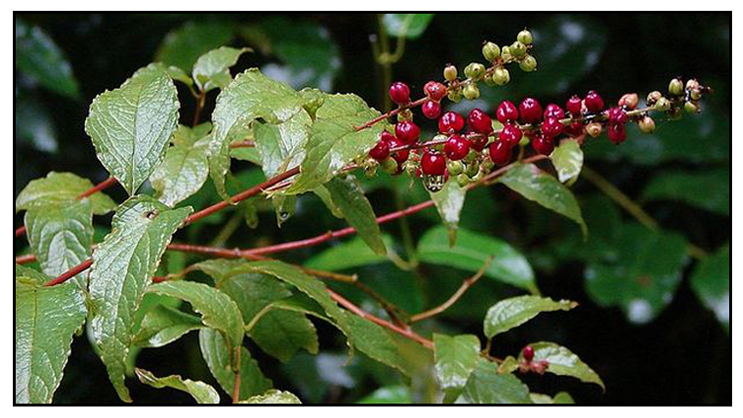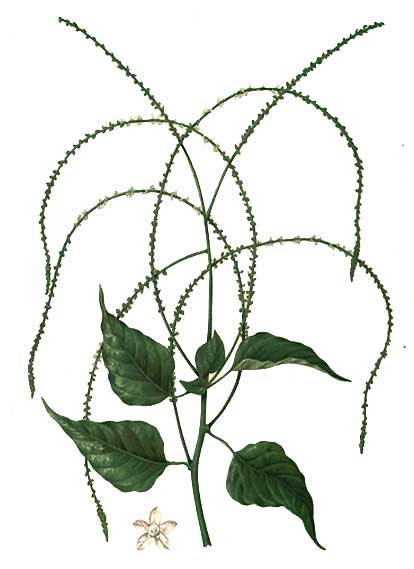
Family • Amaranthaceae
Ditiran
Deeringia amaranthoides (Lamk.) Merr.
SHRUBBY DEERINGIA
Jiang guo xian
| Scientific names | Common names |
| Achyranthes amaranthoides Lam. | Aribugbug (Ilk.) |
| Celosia amaranthoides (Lam.) Medik. | Aribukbuk (Ilk.) |
| Celosia baccata Retz. | Ditiran (Tag.) |
| Cladostachys amaranthoides (Lam.) Roth. | Hagorilis (Tag.) |
| Cladostachys frutescens D.Don | Kanlilimokan (Bis.) |
| Coilosperma cordata Raf. | Sili-silihan (Tag.) |
| Deeringia amaranthoides (Lamk.) Merr. | Suni-suni (Ilk.) |
| Deeringia baccata (Retz.) Moq. | Redberry (Engl.) |
| Deeringia celosioides R. Br. | Shrubby deeringia (Engl.) |
| Deeringia indica Retz. | |
| Deeringia virgata Zipp. ex Span. | |
| Gomphrena amaranthoides (Lam.) Roth. | |
| Mallotus neocavaleriei H.Lév | |
| Phytolacca gracilis Herb. ex Moq. | |
| Deeringia amaranthoides (Lam.) Merr. is an accepted species. KEW: Plants of the World Online | |
| Other vernacular names |
| ASSAMESE: Rangoli-lota. |
| BENGALI: Golamohani, Chhorachhuri saag. |
| CHINESE: Ye xian cai teng, Di ling xian, Jiang guo xian. |
| HINDI: Kalalori, Latman, Wali. |
| INDIA: Methok thoka, Chhorachurisag; Thezute (Nagaland); Okolibo (Arunachal Pradesh). |
| INDONESIA: Bayam besar, Pancaluhur, Bayem luur. |
| HINDI: Kalalobesar, Bajam pohon. |
| THAILAND: Khurea yaang, Phaahom pia a. |
| VIETNAM: D[eef]n leo. |
|
Gen info
Distribution Properties
Studies Availability |
Updated February 2025 /September 2015
![]()
 |
PHOTOS / ILLUSTRATIONS |
| IMAGE SOURCE: Deeringia amaranthoides.jpg / Tatiana Gerus from Brisbane, Australia / Uploaded by berichard / Creative Commons Attribution 2.0 Generic license. / click on image to see source page / Wikimedia Commons |
| OTHER IMAGE SOURCE: Illustration / Deeringia amaranthoides Blanco / Francisco Manuel Blanco (O.S.A) / Public Domain / Wikimedia Commons |
| OTHER IMAGE SOURCE: Amaranthaceae : Deeringia amaranthoides / Leaf / Copyright © 2016 by P.B. Pelser & J.F. Barcelona (contact: pieter.pelser@canterbury.ac.nz) [ref. DOL110509] / Non-Commercial Use / Click on image to go to source page / Phytoimages.siu.edu |
| OTHER IMAGE SOURCE: Amaranthaceae : Deeringia amaranthoides / Flowers / Copyright © 2016 by P.B. Pelser & J.F. Barcelona (contact: pieter.pelser@canterbury.ac.nz) [ref. DOL110520] / Non-Commercial Use / Click on image to go to source page / Phytoimages.siu.edu |
Additional
Sources and Suggested Readings |
• |
DOI: It is not uncommon for links on studies/sources to change. Copying and pasting the information on the search window or using the DOI (if available) will often redirect to the new link page. (Citing and Using a (DOI) Digital Object Identifier) |
| Â Â Â Â Â Â Â Â Â Â Â Â Â Â Â Â Â Â Â Â Â Â Â Â Â Â Â Â Â Â List of Understudied Philippine Medicinal Plants |
| Â Â Â Â Â Â Â Â Â Â Â Â Â Â Â Â Â Â Â Â Â New plant names needed The compilation now numbers over 1,500 medicinal plants. While I believe there are hundreds more that can be added to the collection, they are becoming more difficult to find. If you have a plant to suggest for inclusion, native or introduced, please email the info: scientific name (most helpful), local plant name (if known), any known folkloric medicinal use, and, if possible, a photo. Your help will be greatly appreciated. |
• |
 |
• |


 Botany
Botany Constituents
Constituents